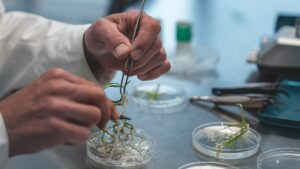Wheat production faces numerous difficulties, from weather to profitability. Three experts explain how plant breeders are tackling these issues.
Wheat production challenges are found across the globe, and plant breeders are creating solutions to those problems with varieties and genetics.
Three wheat experts discuss several hurdles to international wheat production and the solutions that plant breeders have developed to combat these challenges. Five themes emerged: weather, economics, development of hybrid wheat, education and promotion and nutrition and industrial quality.
Weather
Heat stress, drought and weather fluctuations at planting time affect a wheat crop’s yield and quality. Research shows productivity begins decreasing when temperatures exceed 25 degrees Celsius (77 degrees Fahrenheit).
“Wheat doesn’t do well in heat,” says Hans-Joachim Braun, director of International Maize and Wheat Improvement Center’s (CIMMYT) Global Wheat Program. “Every degree Celsius increased, yield is decreased 5-7%.”
In recent years, we’ve seen higher temperatures have been occurring more frequent during flowering in early spring, the most susceptible moment for the crop, explains Filippo Maria Bassi, senior durum wheat breeder with the International Center for Agricultural Research in Dry Areas (ICARDA).
Weather fluctuations during planting creates complications, as well. Some parts of the world, such as the U.S., experience rain and spring freezes, while other parts of the world see increased spring temperatures and reduced rainfall.
Braun says producers in developing countries are concerned about shifts to the ideal planting dates, which affect crop rotations.
“If rain doesn’t come or you plant later, the crop is exposed to heat, and the next crop is planted later,” he says. “The established crop rotation will be disturbed.”
If wheat is not planted in time, producers need to decide how to treat the wheat. For example, Bryan Gerard, president and co-owner of JoMar Seeds, says, if producers plant late, they need to decide if they will keep the crop and plant corn or soybeans or kill the wheat, treating it like a cover crop.
Gerard says a number of acres weren’t planted in the southern U.S. in the fall of 2018 because of all the rain.
On the other hand, countries with reduced rainfall are experiencing a shortage of irrigation water. This means wheat might be grown in more marginal areas, requiring varieties that can cope with drought.
Development of Hybrid Wheat
Last year, scientists completed the sequencing of the entire wheat genome.
“The wheat genome is huge,” Braun says. “It’s the product of three genomes of three grasses. The wheat genome is five times as big as maize, four times as big as a human’s, and 10 to 20 times bigger than the rice genome.”
Because there are three genomes present in wheat, hybridization is difficult. Wheat is a self-pollinated crop, so specific methods are required to generate hybrids. While France and India have some hybrid wheat developed through a chemistry process, it’s only a small part of their market.
In developing countries, the complexity of yield stability, which measures the consistency of a crop yield from year to year, is a concern.
“Many of the farmers we reach are very small, with the average farm size less than half a hectare,” Braun says. “Farmers can only afford to grow one variety.”
If that one variety fails, farmers can’t easily switch. He believes hybrids can provide a better yield stability, although not necessarily a higher yield potential.
“For us, it’s important to develop cultivars with good yield stability,” he says.
Education and Promotion
Gerard notes that there is a false perception that there hasn’t been innovation in wheat.
“The innovation in other crops is very visible, especially since it’s trait driven,” he says. “We as wheat innovators haven’t communicated the innovation and amount of investment that’s gone on during the past 10 years. We need to promote the innovation.”
In North America, investments in wheat are at record levels.
One way that the United States has showcased success in wheat production is with the National Wheat Yield Contest, which began in 2015. The contest, administered by the National Wheat Foundation, judges yield and quality of wheat. The 2018 winner entered a yield of more than 200 bushels per acre, while several contestants yielded more than 100 bushels per acre.
But in some countries, a lack of education about the use of improved management practices is a challenge for farmers.
“This is a lack of integrative agricultural policies, that have unfortunately been more focus on high value crops such as cherries, apples, oranges and olives, and horticulture crops such as tomatoes, potatoes, onions and eggplants for export,” Bassi says. “However, basic management practices for staple crops such as wheat have suffered.”
Other challenges include trial maintenance and information delivery. Research trials are not always well maintained, and the data from these trials is not made public. Inadequate information distribution systems provide a challenge in educating farmers about the advantages of new wheat cultivars.
“Delivery of varieties to farmers is still challenging,” Bassi says, “but new models based on village or farm-based seed enterprises have shown very positive results, both in terms of speed of replacing old ones, as well as facilitating the purchase of new ones by farmers that would normally not have access to credit.”
Farmer-to-farmer agreements let growers delay their payments for new seeds until after the harvest, which means that they don’t need to buy seed with bank credits.
“Sometimes, the seed purchase can be as simple as paying half a lamb when it is butchered, or an agreed fraction of the harvest,” Bassi explains.
Nutrition and Industrial Quality
On a global scale, wheat provides 20% of all calories and protein. The crop is an important source of zinc, Vitamin B and other compounds for many consumers, and varieties are being bred for higher zinc and iron content.
Braun notes that industrial quality, the quality of gluten to make bread, is increasing in importance.
“It’s already important in the developed world in mills,” Braun says. “In the developing world, much of wheat is processed locally. Industrial processing becomes more important because more people live in the cities. They buy flour or finished wheat products.”
Weather changes can affect the final product, as well. Braun notes that while increased carbon dioxide can be good for crop yield, it might not be good for product quality. For example, it may diminish protein quality and quantity.
Most of the vitamins, fiber and other nutritional aspects of wheat are contained in the bran.
These benefits are obtained through whole wheat grain consumption, Braun says.
“We need a campaign for whole wheat grain consumption,” he says. “When we focus on micronutrients, we focus on countries that consume whole grain, as they get whole benefit from wheat grain. About 90% of all wheat flour is from refined wheat, and only 10% is from whole grain. If split 50/50, it would have a tremendous impact on the health of millions in developing and developed countries.”
Wheat Genetics and Variety Selection Are Key
Having completed the sequencing of the wheat genome, scientists now have more genetic information available to develop new varieties and other tools for wheat producers.
Scientists use molecular markers, molecules such as DNA, to reveal an organism’s characteristics. These markers are becoming standard tools for plant breeders. The process of marker-assisted selection then uses information from molecular markers to choose the traits to further develop in a plant.
Also, plant breeders can cut the amount of time needed to develop a new plant variety in half by using double-haploid breeding methods.
Additionally, biometric analysis has become more sophisticated, Braun says.
“You can get more out of your data, such as spatial analysis,” he says. “You can link molecular and phenotypic data and conduct a large analysis, maximizing what you can get out of the data.”
The ability to stack genes also has helped in developing plants with resistance to disease.
“In the past, breeders transferred one resistant gene into a wheat variety, then it was resistant for three to five years,” Braun says. “You only needed one mutation to overcome resistance. Now, we can stack several rust-resistant genes using marker technology.”
Putting several genes together means that more mutations are needed for a disease to overcome the plant’s resistance to that disease. For example, the combination of four genes for disease resistance means that the disease would need four mutations to overcome the plant.
While diseases such as wheat rust can be managed, there are still problems.
“Diseases are popping up in new areas where they have not been reported before,” Braun notes.
For example, prior to 2016, wheat blast was only found in Latin America. That year, cases of wheat blast in Bangladesh caused considerable loss because the plant varieties there had no resistance to the disease. To combat it, farmers needed to switch varieties as quickly as possible.
CIMMYT was able to help with its prior research showing which variety was resistant to wheat blast in Latin America. The organization then compared this information with the varieties available in Bangladesh.
Within one year, Bangladeshi wheat scientists had released a variety resistant to wheat blast that could be used in Bangladesh.
Another organization that works with disease in wheat is the U.S. Scab Initiative, which was developed to reduce the impact of Fusarium Head Blight (scab) on wheat and barley. Its membership consists of federal, state and private sector scientists, as well as growers, millers and food processors, who develop ways to minimize scab threats in wheat and barley.
Gerard adds that innovations within the wheat plant and in farming practices have contributed greatly to disease management.
“Most diseases are manageable if the variety selection is correct,” Gerard says.
Economics, a Must
Gerard says economics is a major factor from the grower’s point of view.
“Farmers will plant wheat if it makes economic sense,” he says. “There’s a huge uptick in production in certain parts of the world, mainly through use of newer varieties and better growing practices.”
Gerard says double cropping might be a good option for some.
“You can harvest wheat in time to put in a crop of soybeans in June and still get a nice return,” he says.
In some places, corn yields are 10-14 percent higher when following wheat than when following soybeans.
According to Gerard, some areas that plant wheat are seeing yield trials with a mean of 100 bushels per acre. Irrigated areas in Egypt also see average yields of 100 bushels per acre.
“Like most commodities, it’s an economic choice,” he says.
Better Production Practices and More Research Could Help
Bassi notes that several agronomic practices can help wheat production, including zero-till and adding legumes to crop rotations to break up cycles of continuous cereal cropping.
Some of the legumes added in rotations include faba bean in Africa, chickpea and lentil in the Middle East and India, and soybeans in the United States.
Precision farming, which includes sowing seeds or applying nutrients at the correct rate exactly where they are needed, can also help. Targeted irrigation practices such as drip or raised-bed methods use water in a smarter way. To produce one kilogram of wheat, 900-1,000 liters of water is needed. If laser leveling is applied, water consumption drops to 600 liters. With drip irrigation, only 400 liters of water is needed.
“A grower can maximize yield potential of wheat by proper investment and management with quality seed (treated and new), nitrogen use, fungicides and more,” Gerard says.
Both Braun and Bassi emphasize the need for support of the public sector in researching wheat.
“Our national research partners are suffering from lack of funding and loss of political support,” Bassi says. “Without investing in the national scientific activities, farmers will be left without the technologies that they so desperately need.”














